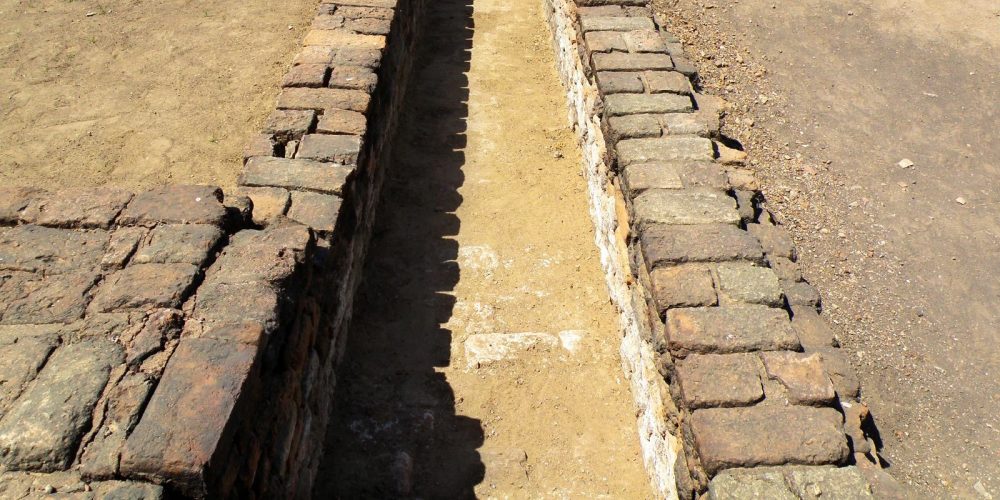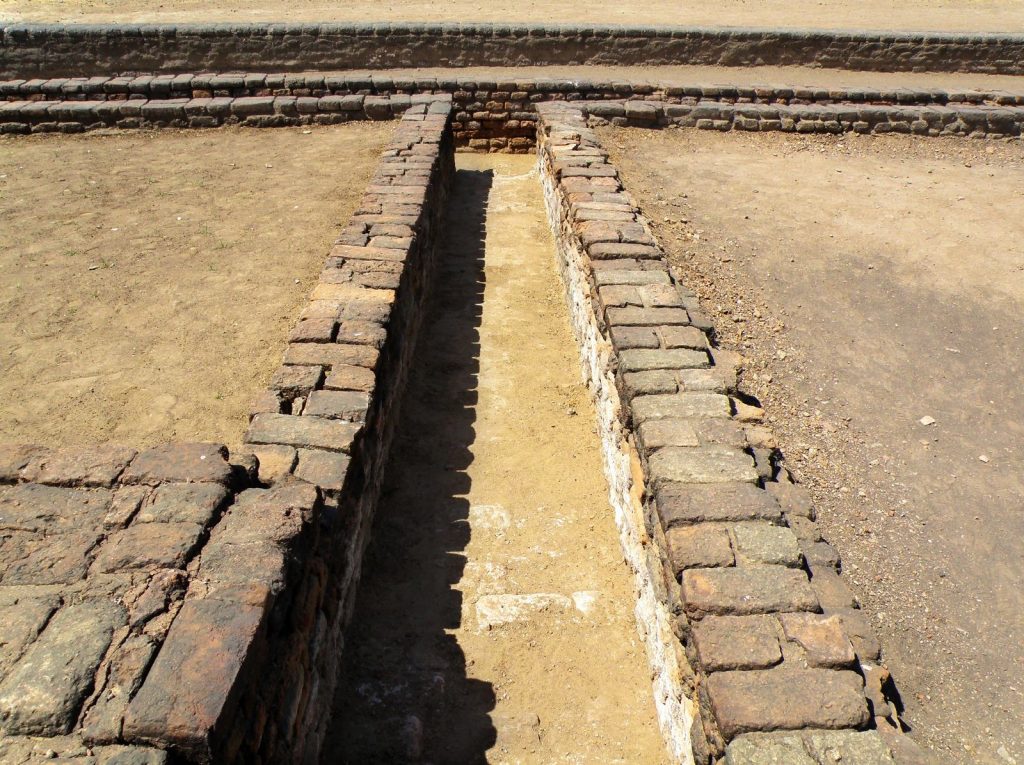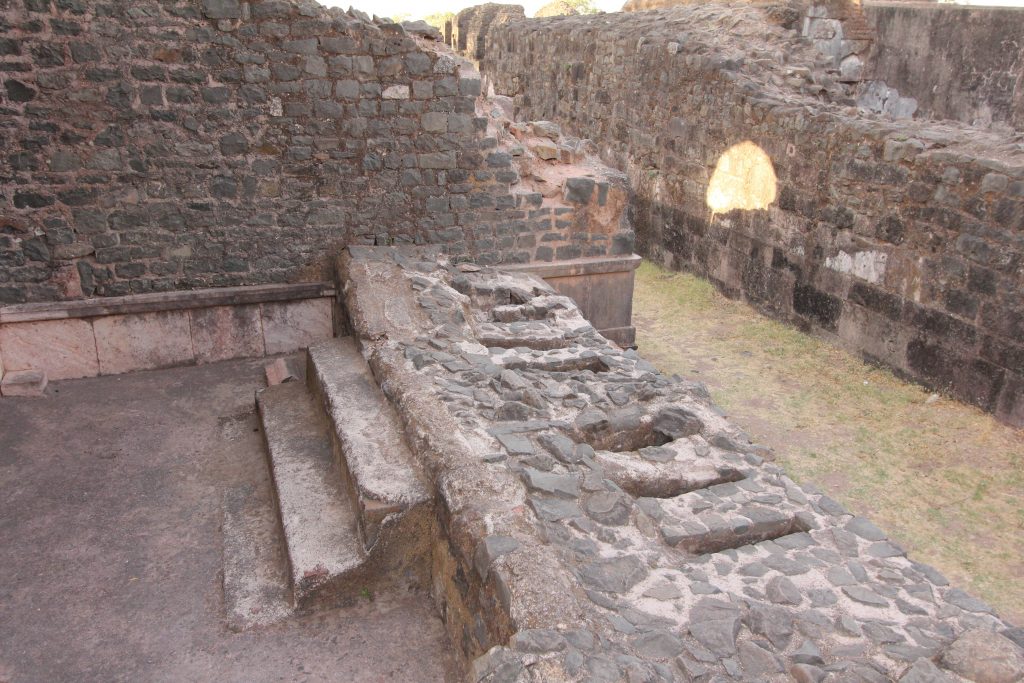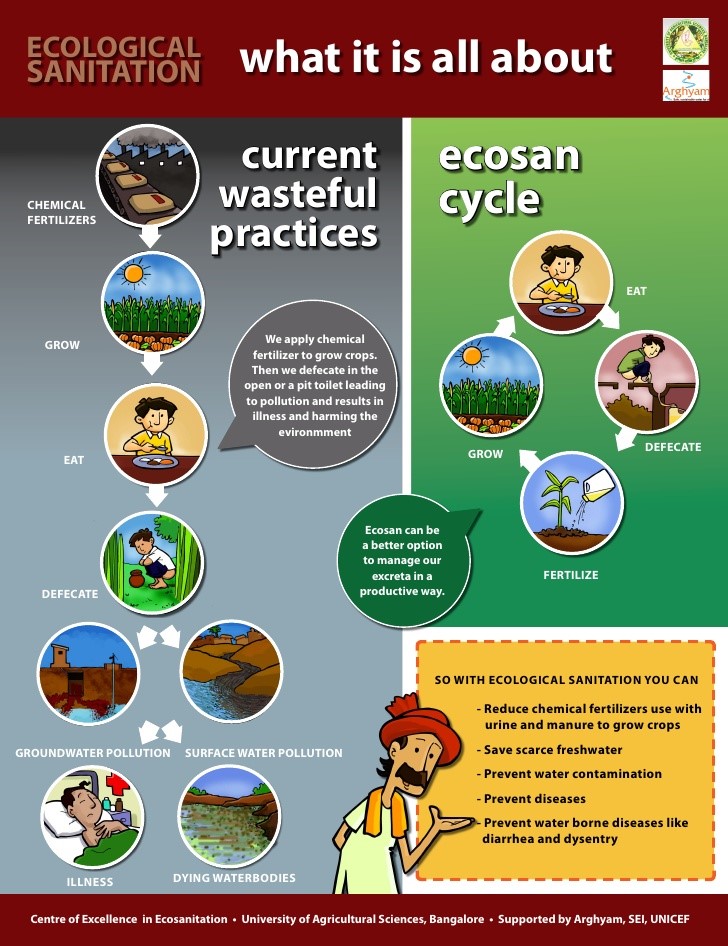Abstract: The world is in the throes of a sanitation crisis today with massive amounts of faecal sludge and wastewater from homes, commercial establishments and industries being discharged into rivers and other water bodies without proper treatment. Drinking water, which is pumped to homes and buildings, is being used to flush solids in toilets. The ensuing wastewater is often not fully treated and little effort is made to extract fertilizers or bio-energy from it. However, there was a time in ancient India when recycling nutrients in human waste was deeply understood and implemented. The practices encoded in Indic texts could have been used to extract global ‘Best Practices’ for sanitation and wastewater management.
Introduction
A sanitation crisis is unfolding today as large amounts of wastewater (used water) from homes, commercial establishments, industries and farmlands are flowing into rivers and other water bodies without proper treatment. Faecal sludge and solid wastes are also finding their way into the food chain. This has led to serious impacts on human health, education, and economy. One part of the crisis is rooted in the practice of using clean water to remove human wastes from toilets, which began with the popularization of flush toilets in the early 20th century. [1]. As piped water began to reach more homes in cities, it was not long before flush toilets became the norm and a big share of clean water was turned to wastewater (to flush the solids). In one press of the flush handle (which typically uses 10-20 litres of clean water), it became possible to send unwanted wastes out of sight. The ensuing sewage or domestic wastewater is often not treated at all or is only partially treated to remove harmful substances such as pathogenic bacteria, pharmaceuticals, hormones etc. Also, there is hardly any effort to extract fertilizers or bio-energy from sewage or solid waste.
However, there was a time in ancient India when hygiene, disease-prevention, environmental protection and the need to recycle nutrients in human waste was deeply understood and implemented. Sanskrit texts such as Sushruta Samhita, Charaka Samhita, Manusmriti, Vayu Purana, Vaastu Shastra, Kamasutra, Arthashastra and others encoded the principles, which could easily have been used to extract global best practices needed for healthy ecosystems in our planet.
The flawed paradigm of modern wastewater management
The modern sewage disposal system consists of pipes (sewers), which collect domestic wastewater from toilets, bathrooms, kitchens, yards and other places where water is used, in order to transport them to centralized treatment plants. [1] At the plants, the sewage undergoes preliminary, primary, secondary and sometimes advanced treatment depending on what quality of treated effluent is desired. Apart from the huge cost of digging underground and installing sewer lines, considerable energy is required to separate solids from water (which should not have been mixed in the first place) at treatment plants after which the treated product water is sent to rivers, lakes, seas or disposed of on land. The separated solids called sludge or biosolids are sent to landfills or incinerated and in a few cases are converted to fertilizer.
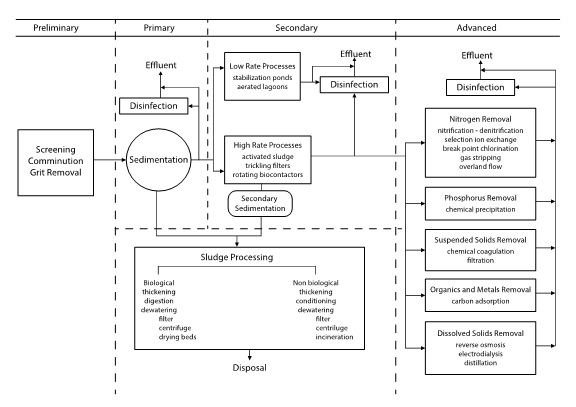
Figure 1: Schematic of modern wastewater treatment (Chapter 2, Municipal Wastewater: Treatment and Reclaimed Water Characteristics by Takashi Asano, Robert G Smith and George Tchobanoglous)
Unfortunately, in many places around the world, due to their huge cost, sewers and wastewater treatment plants either do not exist or they function improperly; therefore untreated sewage is sent directly to water bodies or land leading to the outbreak of diseases, destruction of aquatic life and economic losses. When clean water is provided to a community, it ironically leads to more pollution if the used water generated is not managed properly. According to the United Nations World Water Development Report 2017, on average, high-income countries treat about 70%, upper-middle-income countries treat 38% while the lower middle-income countries treat 28% of the municipal and industrial wastewater they generate. In low-income countries, only 8% undergoes treatment of any kind. Thus, globally, over 80% of all wastewater is discharged without treatment. [20]
The western style water closet (WC) has in fact, proven detrimental to life on this planet, which is acknowledged by many.
The water closet was seen as a victory for public health care, because excrement was moved away immediately from houses and yards. But where was the human excreta going through the sewer pipes? That is yet another question. It went to bodies of water. When it comes to the health of the humans and the state of the environment, the WC was not an improvement; it was a major step backwards. Nutrients were getting out of the use of agriculture and nature’s metabolism into the bodies of water.”
— (Juuti P.S. 2007). (2007) Environmental History of Water. IWA Publishing (Sim 2016)
Today, cities are struggling to find the finances for building sewers and treatment plants. Meanwhile, even when the finances are available, environmental engineers are agonizing over how to efficiently separate solids from wastewater using the least energy, how to chemically treat the solids so that nutrients like phosphorus can be recovered, how to recycle wastewater so that there is lesser burden on the freshwater resources of the world.
The food we eat contains nutrients, which plants have taken from the soil, and the excess nutrients are excreted by the body. Thus, our urine contains valuable phosphate, nitrogen, potassium and other nutrients, which need to go back to nature in order to complete the cycle. Unfortunately, there are only rare instances of these nutrients being recovered for agriculture via the modern sewage disposal system. Importing fertilizers is causing a drain on many countries such as India because phosphorous reserves are confined to a few countries. [17] Currently India imports about 90% of its requirement for phosphate fertilizers. [8] According to 2011 data, the US imports about 85% of its potash and 50% of nitrogen fertilizers. [5]
To put it simply, humans are going through the elaborate process of mining and processing to manufacture fertilizers, applying them to crops, and then losing it all via wastewater. Lakes and streams, which receive an excess of nutrients from wastewater are suffering from serious ecological effects such as oxygen depletion and fish-kills. [17] Also, synthetic fertilizer manufacturing is an energy-intensive industry and is expected to increase to feed an ever-growing population. [22]
Ancient Indic understanding of hygiene and environmental pollution
The importance of hygiene has been highlighted in many ancient Indic texts. Whether it was general hygiene in terms of bathing or washing hands and feet, or whether it was sexual hygiene, many Sanskrit texts make it clear that a lack of hygiene leads to diseases. It was also understood that disease-causing pathogens in feces needed to be isolated from human settlements and nutrients in wastes had to be safely recycled back to nature. Under no circumstances were human wastes, blood or hazardous substances to be allowed to contaminate water.
“The river having water polluted with soil and feces, insects, snakes and rats and carrying rainwater will aggravate all doshas. Slimy, having insects, impure, full of leaves, moss and mud, having abnormal color and taste, viscous and foul smelling water is not wholesome.”
— Charaka Samhita, Sutrasthanam 27.213, 214[9]
The Manusmriti has allotted many verses to disallowing the pollution of rivers, water bodies, ploughed lands, cow pens, brick altars or even holes inhabited by living creatures. It prohibits urinating while facing the wind for obvious reasons. The text also lists out the impure substances produced by human bodies thereby indicating that after touching all these things, one would need to be cleansed. Among the impurities are oily exudations, semen, blood, urine, feces, nasal mucus, earwax, phlegm, tears and sweat. The mention of avoiding ploughed lands is important because this indicates an understanding that the direct application of human feces to crops is not a healthy practice. [11, 12, 13, 15]
Let him not throw urine or feces into the water, nor saliva, nor clothes defiled by impure substances, nor any other impurity, nor blood, nor poisonous things.
Manusmriti, 4.56 [15]
Far from his dwelling let him remove urine and ordure, far let him remove the water used for washing his feet, and far the remnants of food and the water from his bath.
Manusmriti, 4.151[15]
Vedic people living in villages walked a long distance from their houses to relieve themselves primarily because they knew the dangers of contamination of food and water by fecal matter. Defecation in the open was followed by covering up of the feces with soil so that no insects would spread infection. The left hand was used for anal washing with some water carried to the spot in a small container and this hand was cleansed thoroughly either with plant-based soaps or with sand. The left hand was not used for eating because it was associated with the touching of impure substances.
Since drinking water was obtained from wells, lakes, tanks and ponds, it was important to keep these sources clean and away from contamination. Rules for preserving the purity and sacredness of water sources are found even in the ancient epic of Mahabharata. The Sanskrit treatise Arthashastra from the third century BCE mentions severe punishments for polluting water sources. [11]
In ancient India, it was possible for rural people to find isolated places far away from habitation as well as from water bodies where, after defecation, the wastes would be safely absorbed into the soil without polluting water or land. Another advantage was that no manual scavenging was needed. With burgeoning populations, it became harder to find such sequestered places, as a result of which the practice of defecating outdoors began to increase the risk of disease. Open defecation cannot be sustained beyond a certain density of population. Even just five decades ago, population densities were not too high. There is an erroneous assumption in some quarters that India’s open defecation problem is rooted in a lack of hygiene that springs from ancient Hindu texts. [7] Such an assumption betrays a lack of awareness of the scientific approach to health and disease that was prevalent in Vedic times. In fact, the whole problem of squalor in Indian cities today stems from a lack of awareness of Hindu texts and a lack of design of sanitation in accordance with Vedic principles of hygiene.
Urban wastewater disposal systems of ancient India
Unlike rural dwellers, latrines and sewerage were well known to city-dwellers in ancient India. The people of the Indus-Sarasvati civilisation were the earliest to use latrines, soak pits, cesspools, pipes and channels for wastewater disposal. Both centralized and decentralized systems have been found in different archaeological sites, some of which go back 8,000 years. Some toilets just had holes in the ground while others had seats. In the centralized disposal model, which has been found in Mohenjo-daro, Harappa, Chanhu-daro, Lothal and other places in Greater India, terracotta pipes carried both bathwater and effluents from pour-flush toilets into the street drains. The effluents were collected in pits lined with clay bricks so that solids could settle and when it was three-quarters filled, the supernatant liquid could flow into a wider drain downstream. It can be guessed that the pits were emptied manually and the biosolids sent for disposal to specific sites. Also, the pits were located at the intersection of several drains so that clogging could be prevented. Meanwhile, in the decentralized disposal model found in Kalibangan, Banavali and other places the effluents from were transferred from households via U-shaped channels into perforated jars placed in the main streets. The biosolids were emptied from the jars periodically. [2]
There is a mistaken belief that urban wastewater management systems were only found in Indus-Sarasvati civilization. In fact, terracotta pipes and brick lined soak pits have been found in Takshshila, Delhi, Ujjain and Arikamedu, which are all located in different parts of India. [2] Further excavations might reveal more ancient towns with well-developed wastewater management systems. Arikamedu, which was a noted centre for textile production has the unique distinction of featuring industrial wastewater systems dating to the first century before the common era. [2] The port city had close trading relations with Rome.
However, the majority of India’s population lived in rural areas or in the periphery of cities, and therefore relieving oneself in open areas far away from housing was more prevalent than the use of toilets. After the Muslim occupation of India, it became common for harems inside forts to have rows of toilets for the women, since the royal womenfolk were not allowed to go outside. It has been speculated that the practice of manual scavenging got intensified during this period, since more and more people were needed to carry the excreta from households. Typically, captured slaves were used for the purpose. [6]
European colonization and the ignorance of systematic water pollution
After the European colonizers began to impose in India the so-called modern flush toilets and sewerage systems that they were using in their home countries, the sanitation landscape of the country began to change. The cantonments where the British lived looked neat but the sewage they produced was polluting the countryside. Unfortunately, this system of so-called sanitation was considered modern and became so fashionable that it spread vigorously to the rest of the country even after the colonizers were expelled.
One of the worst epidemics associated with poor sanitation is cholera. While the disease is mentioned in ancient Indian medical texts, it appears that there were only sporadic cases and not epidemics. [4] Besides, those texts already cautioned people to refrain from polluting water sources or drinking water that was contaminated. The first cholera pandemic in India occurred in British-occupied Bengal in 1817 when large numbers were affected in the British army and spread to other places. [4, 16]
It is interesting that the miasma theory prevalent in Europe promoted the dumping of human waste into water bodies. According to this obsolete theory, diseases are caused by bad air or foul odours. The water closet or flush toilets were hailed by Londoners because it removed smells from housing in accordance with the miasma theory. Excreta was disliked only for its smell not for its potential to cause disease. The more it was dumped in the Thames, the safer the residents of London felt [16]. “The city’s sewer commissioners proudly noted the huge volume of human waste that the city’s toilets efficiently deposited into the river; twenty nine thousand cubic yards in the spring of 1848 and eighty thousand cubic yards by the winter of 1849.” [16] The Times reported in 1858 that death rates had declined because the Thames had grown fouler. In other words, the connection between water pollution and disease had not been made yet. There was total ignorance about the fact that when the tide in the North Sea rose, the filth in the Thames was going right back upstream to the intakes of the drinking water companies. [16]
“Nevertheless under the powerful influence of miasmatism, when cholera struck, Londoners believed it was not because too many flush toilets dumped human waste into the river, but because too few did. Flush toilet sales, in the years after the 1832 epidemic, enjoyed “rapid and remarkable growth” according to an 1857 report. Flush toilet sales enjoyed another spike after an 1848 outbreak of cholera. So many Londoners installed flush toilets over the 1850s that the city’s water use nearly doubled between 1850 and 1856”[16]
— Sonia Shah, Tracking Contagions from Cholera to Ebola and Beyond, 2016, Sarah Crichton Books, New York
Ancient India’s sanitation principles provided a standard for sustainable wastewater management
Given the tendency to use minimal water and to follow the age-old concept of isolation of wastes, it is possible that if Indians had stayed connected with their ancient knowledge, they could have naturally gravitated towards ecological sanitation or ecosan or composting toilets. Generating fertilizers and/or bioenergy from wastes could also have been a natural corollary to such toilets. A system, which sends wastewater from toilets to rivers as sacred as the Sarasvati or Ganga could simply not have originated in ancient India.
In other words, had engineers globally devised a set of ‘Best Practices’ out of the Vedic strictures of not mixing human wastes with clean water, not sending wastewater to freshwater bodies and ensuring that nutrients were safely recycled back to nature, we would have a cleaner, healthier and liveable world today.
“The most environmentally friendly type of toilet is the compost toilet, especially the dry compost model in which urine is collected separately. Urine diluted with water can be used as fertilizer and composted solid waste can be used for soil improvement. The annual amount of urine for one individual could be used to produce 200 kilograms of grain. This method not only recycles the materials in the urine but it also prevents them from getting into groundwater and watercourses. The whole process is manageable by people themselves. The separating model also has a less distinctive smell. It is notable that in the 19th century there was already dry compost and compost toilets in cities combined with different transport systems. Choosing the water closet as the primary system in the late 19th and early 20th centuries ended the product development of dry compost and compost toilets for over a hundred years.
— Juuti P.S. and Wallenius K.J. (2005). Brief History of Wells and Toilets.Pieksamaki.
There has been much controversy over the poor treatment of the jaatis in India that were involved in manual scavenging. However, it must be remembered that throughout history, the task of handling wastes and faeces has never been a dignified one. [18] Until as late as the 20th century, human excrement had to be removed physically from cesspits and privies in Europe. [16,18] The European lower-caste people who did the dirty job were called gongfermours (French) or gong farmers in English. [18] The gong farmers of England were only allowed to work at night, so they were also called nightmen. They came into respectable neighbourhoods in the dead of the night, emptied cesspits and carted away the wastes to the boundaries of the cities. They were required to live in certain areas at the fringes of the city and could not enter the city during daytime. There were severe penalties for breaking this rule. Even after water closets arrived on the scene, their contents flowed into cesspits for a long time and needed to be cleaned out by nightmen. [18]
Worldwide, until modern systems of transporting and handling sewage and sludge using advanced technologies came into existence, workers in this sector were ostracized from society. [18]
Closing thoughts
Today’s cities are stuck with a water supply and wastewater disposal system, which cannot be redesigned with ecological principles unless huge amounts of capital expenditure are incurred. Over the decades, the thinking has gravitated towards making a wrong design a little more right. Therefore, many cities are adopting measures such as installing low-flush toilets, recycling of wastewater for non-potable uses, extracting biosolids etc. A few cities such as Windhoek (Namibia) and Singapore are recycling used water even for potable use. But the fact remains that in the poorer parts of the world, the cost of laying a network of sewers and treatment plants is quite unaffordable.
Meanwhile, there is also a parallel move to install ecosan toilets in rural areas, which has been successful in varying degrees. Champions of ecosan toilets are carrying out tiny revolutions in various parts of the world and demonstrating how sanitation can turned into a virtuous sustainability business, which generates fertilizers and/or energy. In 2011, the Bill and Melinda Gates Foundation announced the “Reinvent the Toilet Challenge” to researchers around the world to develop innovative and financially profitable systems to manage human waste, which would be off-grid and cost less than US$0.05 per day. [14] Millions of dollars of grants have been awarded to researchers so far and the Challenge is now in its third phase. [14] About US$ 7 million is currently being used to develop an off-grid, energy-neutral sanitation system by Duke University, along with its partners RTI International, Colorado State University and several other partners. [14] The project is currently undergoing testing in India. Kohler, a leading toilet manufacturer in the US has been awarded US$ 1 million to test closed-loop toilets in poor countries. [14] According to Kohler, these toilets will be stand-alone units that take in wastewater, then disinfect and purify it to be reused for toilet flushing. [14]
For now, the world will continue to be divided between those connected to the sewerage grid and those who are not. It is impossible to reverse the centuries of mismanagement of human waste. We have moved very far from the wisdom of ancient rishis when it comes to answering the call of nature. However, there is a window of opportunity to find the right paradigm for those who are not connected to sewer networks.
*Sahana Singh is Editor of Asian Water Magazine (www.asianwater.com.my) and Director, Indian History Awareness and Research (IHAR), a Houston-based think tank. She writes on water management, environment and Indian history, and has recently authored a book titled “The Educational Heritage Of Ancient India – How An Ecosystem of Learning Was Laid To Waste”.
Acknowledgements
The author would like to thank public policy expert Dr Kallidaikurichi Seetharam for his valuable inputs; Arnab Bhattacharya for his help with references and the IHAR team for their review of this work.
Bibliography
- Alter, Lloyd. Why the modern bathroom is a wasteful, unhealthy design. July 15, 2014. https://www.theguardian.com/lifeandstyle/2014/jul/15/why-modern-bathroom-wasteful-unhealthy-design.
- Andreas N. Angelakis, Joan B. Rose,. Evolution of Sanitation and Wastewater Technologies through the Centuries . IWA Publishing, 2014.
- Coffey, Diana. Culture, Religion and Open Defecation in Rural North India. http://www.ideasforindia.in/article.aspx?article_id=329.
- Dhiman Barua, William B. Greenough II. Springer Science + Business Media, 1992.
- “Fertilizer Imports/Exports.” United States Department of Agriculture. December 23, 2016. https://www.ers.usda.gov/data-products/fertilizer-importsexports/.
- George, Rose. The Big Necessity – The Unmentionable World of Human Waste And Why It Matters. Picador, 2014.
- Harris, Gardiner. Poor sanitation in India may affect well-fed children with malnutrition. https://www.nytimes.com/2014/07/15/world/asia/poor-sanitation-in-india-may-afflict-well-fed-children-with-malnutrition.html.
- India’s flawed fertilizer policy. April 1, 2015. http://www.livemint.com/Opinion/XCCJwEzbzwiyWFYfK1wRdO/Indias-flawed-fertilizer-policy.html.
- James, George Alfred. Ethical Perspectives on Environmental Issues in India. Delhi: A.P.H. Publishing Corporation, 1999.
- Juuti P.S., Katko T.S. & Vuorinen H.S. The Environmental History of Water. IWA Publishing, 2007.
- V. Raju, S.Manasi. Water and Scripture: Ancient Roots for Sustainable Development. Springer, 2017.
- Manusmriti in Sanskrit with English translation. https://archive.org/details/ManuSmriti_201601.
- Manusmriti with the commentary of Medhatithi. https://www.wisdomlib.org/hinduism/book/manusmriti-with-the-commentary-of-medhatithi/d/doc200149.html.
- Moses, Sue-Lynn. The Gates Foundation Is Still Making Grants To Reinvent The Toilet. September 12, 2017. https://www.insidephilanthropy.com/home/2017/9/12/gates-toilet-challenge-grants-stoner.
- Hinduism Toilet Rules Manusmriti. https://ramanan50.wordpress.com/2014/10/20/hinduism-toilet-rules-and-rituals-manusmriti/ .
- Shah, Sonia. Tracking Contagions from Cholera to Ebola and Beyond. New York: Sarah Crichton Books, 2016.
- Sim, Ryan. “The Essential Element: How Phosphorus Scarcity Endangers the World.” Harvard International Review, August 2016.
- Singh, Sahana. Why is the world so obsessed with India’s caste system? May 5, 2016. https://indiafacts.org/why-is-the-world-so-obsessed-with-indias-caste-system/.
- Tagare, G.V. Vayu Purana English Translation.
- The United Nations World Water Development Report 2017, Wastewater – The Untapped Respurce. UN-Water, United Nations Educational, Scientific and Cultural Organization.
- Torero, Maximo. “The Fertilizer Market at the Global Level.” The International Food Policy Research Institute. April 30, 2015. https://www.ifa.ie/wp-content/uploads/2015/05/IFPRI-Presentation-wp.pdf.
- Yuan, Mengyao. “Managing Energy in Fertilizer Production and Use.” Coursework for PH240, Stanford University, 2014.
The paper “Best Practices in Indic Hygiene, Sanitation And Environmental Protection – How Did Modern Sanitation Lose Its Way?” was originally presented at Waves 2018 and has been republished with permission.
Disclaimer: The opinions expressed within this article are the personal opinions of the author. IndiaFacts does not assume any responsibility or liability for the accuracy, completeness, suitability, or validity of any information in this article.
Sahana Singh writes on environmental (water) issues, current affairs and Indian history. She is a member of Indian History Awareness and Research (IHAR), and has recently authored “The Educational Heritage of Ancient India – How An Ecosystem of Learning Was Laid to Waste”.

